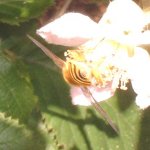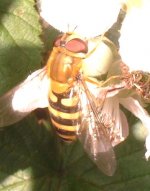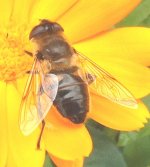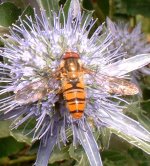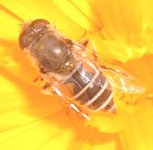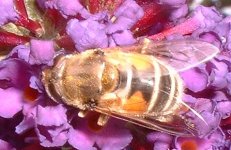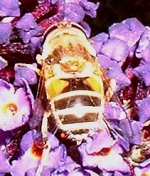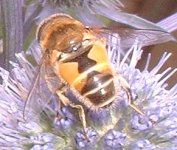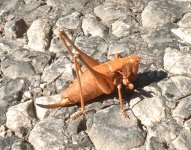-
Welcome to BirdForum, the internet's largest birding community with thousands of members from all over the world. The forums are dedicated to wild birds, birding, binoculars and equipment and all that goes with it.
Please register for an account to take part in the discussions in the forum, post your pictures in the gallery and more.
You are using an out of date browser. It may not display this or other websites correctly.
You should upgrade or use an alternative browser.
You should upgrade or use an alternative browser.
Anyone know their hoverflies? (1 Viewer)
- Thread starter Surreybirder
- Start date
More options
Who Replied?Surreybirder
Ken Noble
Surreybirder
Ken Noble
Charles Harper
Régisseur
NO ONE knows their hoverflies, Kenneth-- give us a break! Maybe you spelled elegans wrong, though.
Surreybirder
Ken Noble
You'd be surprised, Charles, hoverflies are a popular (but difficult) group in the UK. There's a yahoo group devoted to them.
And, if British Hoverflies by Stubbs and Falk is correct, there really is one called Epistrophe eligans!
And, if British Hoverflies by Stubbs and Falk is correct, there really is one called Epistrophe eligans!
Charles Harper
Régisseur
I bow to your erudition.
Surreybirder
Ken Noble
eru... what ?
(I can assure you I'm a complete novice--I am not even sure how you tell a hoverfly from a bee, except when I see it hovering!!)
Just for the record, Stuart Ball from UK-hoverflies yahoogroup writes:
(I can assure you I'm a complete novice--I am not even sure how you tell a hoverfly from a bee, except when I see it hovering!!)
Just for the record, Stuart Ball from UK-hoverflies yahoogroup writes:
The first one (black and yellow striped) is probably Syrphus ribesii because
its female (eyes separated on top of head) and its hind femora is yellow in
at least the (visble) apical half - but you cannot rule out S. rectus on the
basis of this photo - need it under a microscope to look at the microtrichae
on 2nd basal cell!
The second (bee-mimic) is Eristalis pertinax - yellow front tarsi visible.
Surreybirder
Ken Noble
hover2
Not cheap, I bet, I think I'll stick with first edition and supplements.
Here's a few more I need help with!
EDIT Stuart Ball has kindly identified this one for me. It's the Marmalade fly, Episyrphus balteatus, apparently the commonest and most widespread hoverfly in Britain.
Second edit See also photo HERE
Not cheap, I bet, I think I'll stick with first edition and supplements.
Here's a few more I need help with!
EDIT Stuart Ball has kindly identified this one for me. It's the Marmalade fly, Episyrphus balteatus, apparently the commonest and most widespread hoverfly in Britain.
Second edit See also photo HERE
Attachments
Last edited:
Surreybirder
Ken Noble
Surreybirder
Ken Noble
Surreybirder
Ken Noble
1st is Syrphus ribesii, followed by a dark form of eristalis tenax,
Hover Two is the migrant Episyphus balteatus, Hover one. is the Drone fly Eristalis nemorum as is hover three & still hover three.
Look out for nay Hover flies that have white abdomens or are found dead on grass stems. These are carrying the fungus Entomophora muscae.
Hope this helps
Colin J.
Hover Two is the migrant Episyphus balteatus, Hover one. is the Drone fly Eristalis nemorum as is hover three & still hover three.
Look out for nay Hover flies that have white abdomens or are found dead on grass stems. These are carrying the fungus Entomophora muscae.
Hope this helps
Colin J.
Surreybirder
Ken Noble
thanks for all your help, Colin. They are tricky little creatures.
Could you tell me whether this hoverly, seen at the same time is yet another example of E. nemorum--it seems to have more yellow on the third tergite.
(I'm afraid I'm ignoring the smaller species entirely!)
Just as a matter of interest, how many species of hoverfly would you expect to find in a typical southern English garden, during the course of a year. (I've identified c10 so far but there are quite a few I have no idea what they are.)
Could you tell me whether this hoverly, seen at the same time is yet another example of E. nemorum--it seems to have more yellow on the third tergite.
(I'm afraid I'm ignoring the smaller species entirely!)
Just as a matter of interest, how many species of hoverfly would you expect to find in a typical southern English garden, during the course of a year. (I've identified c10 so far but there are quite a few I have no idea what they are.)
Attachments
steve_nova
Well-known member
At work the other week my attention was diverted to something moving in the part water filled gunge at the bottom of a wooden barrel. It turned out to be the larvae or "maggot" of above mentioned Eristalis (Drone Fly). It was using it's long tail syphon to breath and I was surprised how long it could extend it to break to the surface, at least 4-5 times the length of it's body. Isn't nature fascinating!
Last edited:
This may be a bit late but ....Surreybirder wrote:
"Just as a matter of interest, how many species of hoverfly would you expect to find in a typical southern English garden, during the course of a year. (I've identified c10 so far but there are quite a few I have no idea what they are.)"
Well....Ive been recording hoverflies in my garden (St Albans) for the last ten years or so and have recorded 96 species (over one third of the British list) with 50 to 65 being typical for any one year. Most hoverflies are pretty mobile so the list contains many 'tourists' that almost certainly dont breed in the garden itself. However some species like Merodon and some Eumerus are almost dependent on garden (they munch through your bulb plants!) and I guess that over half the species I've recorded breed regularly or at least occasionally.
Ian Wynne
"Just as a matter of interest, how many species of hoverfly would you expect to find in a typical southern English garden, during the course of a year. (I've identified c10 so far but there are quite a few I have no idea what they are.)"
Well....Ive been recording hoverflies in my garden (St Albans) for the last ten years or so and have recorded 96 species (over one third of the British list) with 50 to 65 being typical for any one year. Most hoverflies are pretty mobile so the list contains many 'tourists' that almost certainly dont breed in the garden itself. However some species like Merodon and some Eumerus are almost dependent on garden (they munch through your bulb plants!) and I guess that over half the species I've recorded breed regularly or at least occasionally.
Ian Wynne
Surreybirder
Ken Noble
Ian,
That must be some sort of record. I was told on the Hoverflies-UK yahoogroup of someone who had recorded 90 species in 20 years in Leicester... but your count leaves her in the shade!
My garden list stands at about 10, mainly because I am so bad at identifying them!!
Thanks for your reply.
That must be some sort of record. I was told on the Hoverflies-UK yahoogroup of someone who had recorded 90 species in 20 years in Leicester... but your count leaves her in the shade!
My garden list stands at about 10, mainly because I am so bad at identifying them!!
Thanks for your reply.
Surreybirder
Ken Noble
Are hoverflies possible to ID from photos?
I am interested to note that two experts, Colin J and Stuart Ball, disagree on the identification of all the above hoverflies except Syrphus ribesii (which SB has as only a probable). They don't even agree on the genus of one!
Hoverflies are clearly not for the faint-hearted!
Mind you, bush crickets may be even worse.
I am interested to note that two experts, Colin J and Stuart Ball, disagree on the identification of all the above hoverflies except Syrphus ribesii (which SB has as only a probable). They don't even agree on the genus of one!
Hoverflies are clearly not for the faint-hearted!
Mind you, bush crickets may be even worse.
Attachments
Surreybirder wrote:
'That must be some sort of record. I was told on the Hoverflies-UK yahoogroup of someone who had recorded 90 species in 20 years in Leicester... but your count leaves her in the shade!'
Well... 96 may sound a lot (and ten years ago I certainly would have been surprised) but actually the DIVERSITY is quite low - ie a lot more effort required to gain the same number of species as for, say, a decent wood.
Jennifer Owen in Leicester uses a Malaise trap, which is excellent for quantitative comparisons, but like all trapping methods I suspect there are biases that mean some species are never/rarely caught. I just record presence/absence on any particular day by hand netting/observation so I guess my records will reflect my own mix of recording prejudices and experience (or lack of it). Also, like other plants and animals, many hoverflies have restricted (Southern) distributions so species frequent in my garden (eg Volucella inanis and Cheilosia soror) may simply not occur in her area. Long term studies such as these tend to reflect regional diversity after a while as has been indicated by long term monitoring of moths by the Rothamsted Insect Survey.
Surrey should be even better!!!. It is probably one of best counties in Britain for hoverflies and also by far the best recorded - with an excellent book availbale by Roger Morris (1998, Surrey Wildlife Trust).
all the best
ian wynne
'That must be some sort of record. I was told on the Hoverflies-UK yahoogroup of someone who had recorded 90 species in 20 years in Leicester... but your count leaves her in the shade!'
Well... 96 may sound a lot (and ten years ago I certainly would have been surprised) but actually the DIVERSITY is quite low - ie a lot more effort required to gain the same number of species as for, say, a decent wood.
Jennifer Owen in Leicester uses a Malaise trap, which is excellent for quantitative comparisons, but like all trapping methods I suspect there are biases that mean some species are never/rarely caught. I just record presence/absence on any particular day by hand netting/observation so I guess my records will reflect my own mix of recording prejudices and experience (or lack of it). Also, like other plants and animals, many hoverflies have restricted (Southern) distributions so species frequent in my garden (eg Volucella inanis and Cheilosia soror) may simply not occur in her area. Long term studies such as these tend to reflect regional diversity after a while as has been indicated by long term monitoring of moths by the Rothamsted Insect Survey.
Surrey should be even better!!!. It is probably one of best counties in Britain for hoverflies and also by far the best recorded - with an excellent book availbale by Roger Morris (1998, Surrey Wildlife Trust).
all the best
ian wynne
Re: Are hoverflies possible to ID from photos?
Surreybirder said:I am interested to note that two experts, Colin J and Stuart Ball, disagree on the identification of all the above hoverflies except Syrphus ribesii (which SB has as only a probable). They don't even agree on the genus of one!
Hoverflies are clearly not for the faint-hearted!
Certainly I guess most hoverfly 'experts' (I prefer the word 'specialist' myself - you are always learning new things) would not be entirely happy identifying species of certain genera from photographs.
Syrphus and Eristalis contain several species that might require examining with a hand lens (or even microscope) or to be photographed from a certain angle to be sure.
However there are plenty of species (eg your picture of Episyrphus balteatus) that are very distinctive and could be recorded using photography.
The best way for a beginner though, would be to build a small voucher collection to gain familiarity with individual species and those with which it might be confused. Once you are confident of what you can and can't identify in the field the number of vouchers you will need retain will be become a lot smaller, but is still recommended or essential for certain genera (eg Sphaerophoria and Cheilosia).
The good news is there is an excellent guide available (Stubbs and Falk, BENHS) that has recently been updated containing excellent, user-friendly keys and superb colour plates.
best wishes
ian wynne
Users who are viewing this thread
Total: 2 (members: 0, guests: 2)




